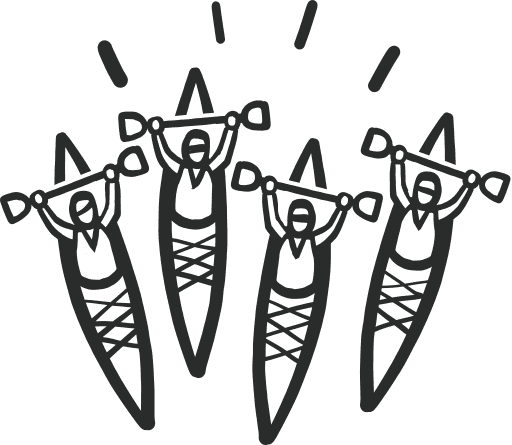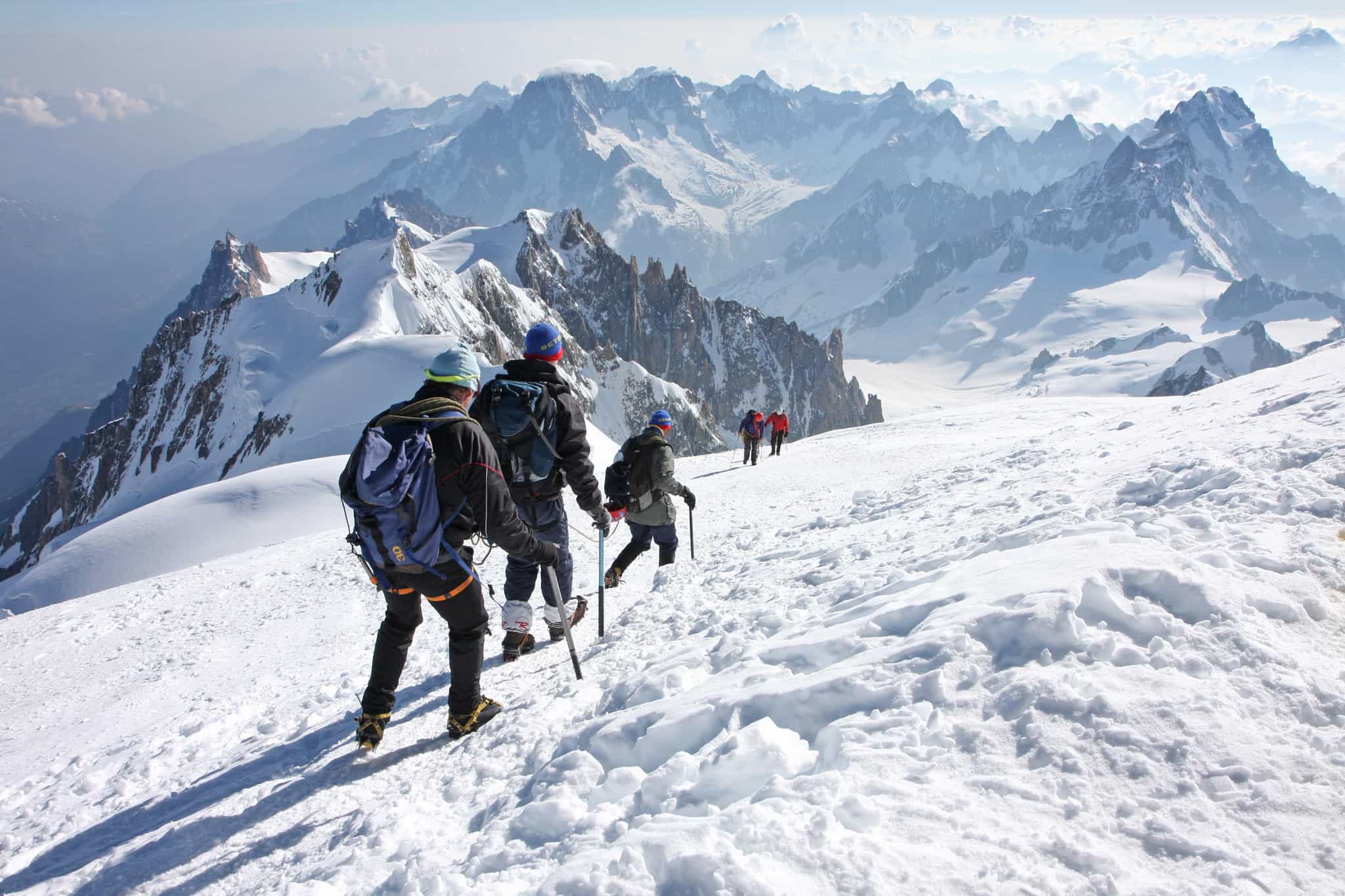
Climb Mont Blanc (4805m)
Tackle the highest peak in Western Europe during the climb of a lifetime, testing your tenacity on the mountaineer’s mountain
What's Included?
Activities & Certified Guides
All itinerary activities with expert, qualified mountaineering guidesHotel & Mountain hut
4 nights in mountain huts and 3 nights in a hotel in ChamonixMeals
All breakfasts, 5 lunches, 4 dinnersTransfers
All transport between locationsEquipment
Blankets or duvets are provided at the mountain refugesSmall Like-minded Groups
Solo-friendly by design, join our small n’ sociable groups of up to 6 like-minded, active and outdoorsy people…
…
What's it like?



























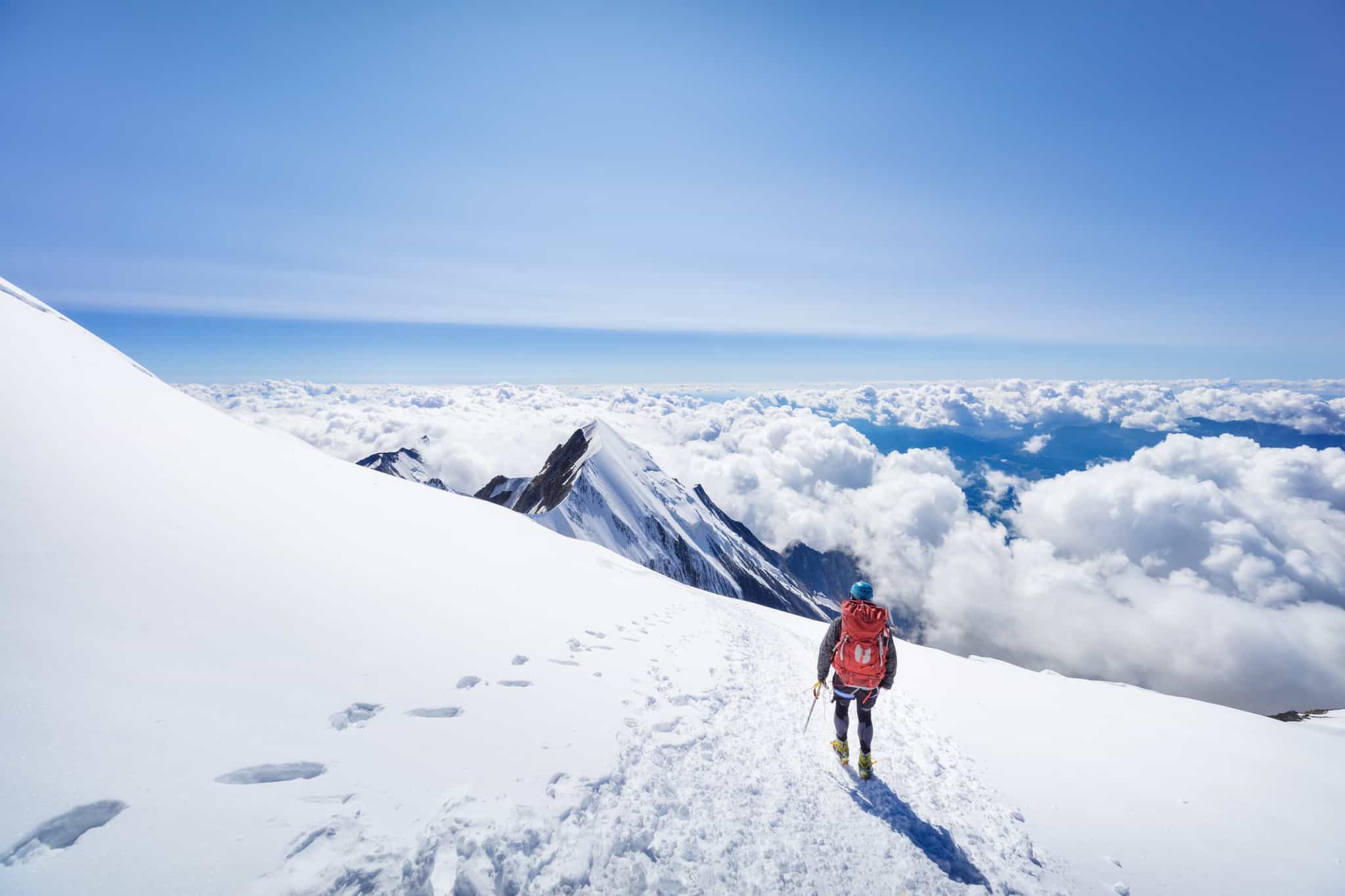
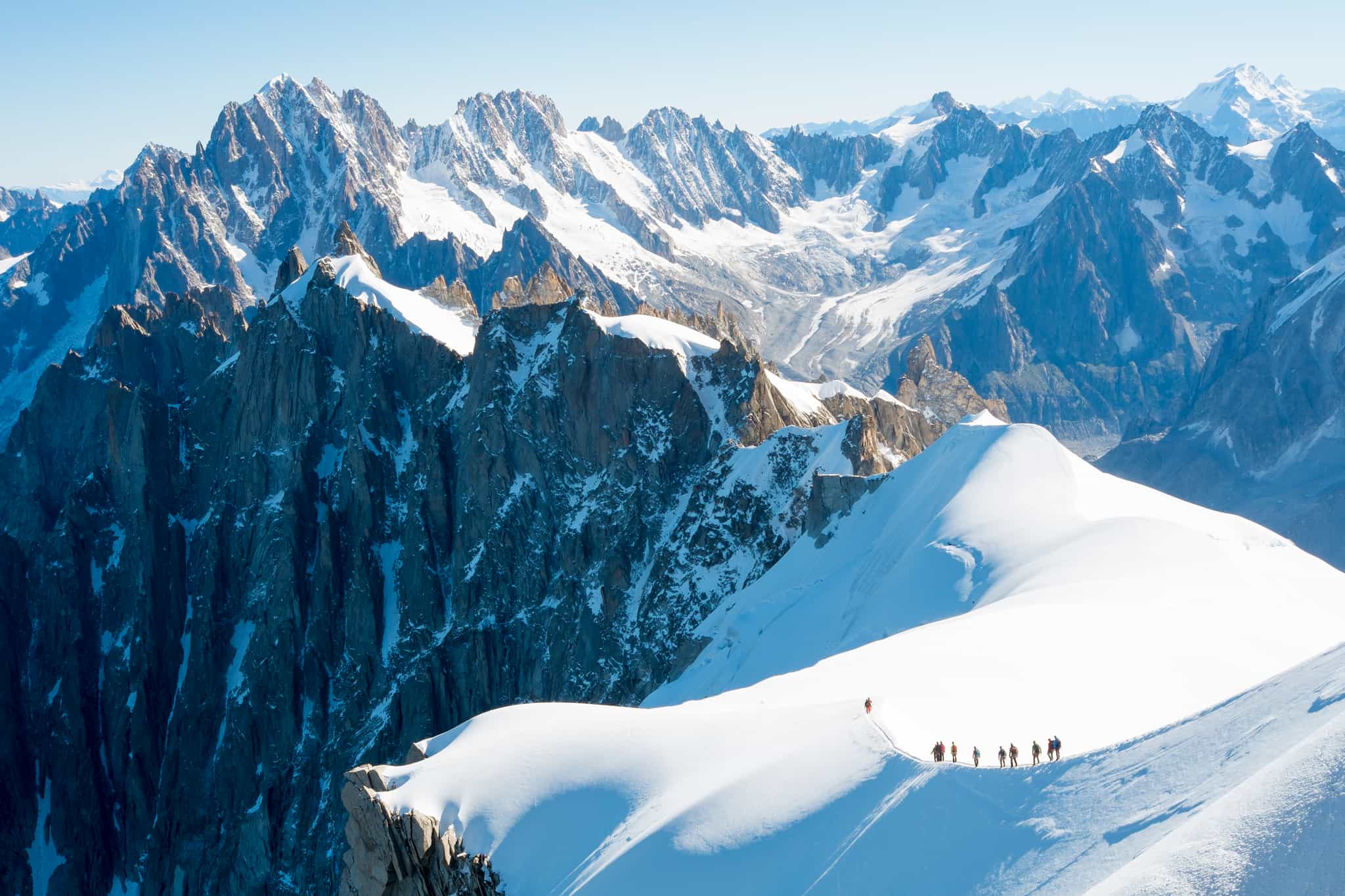
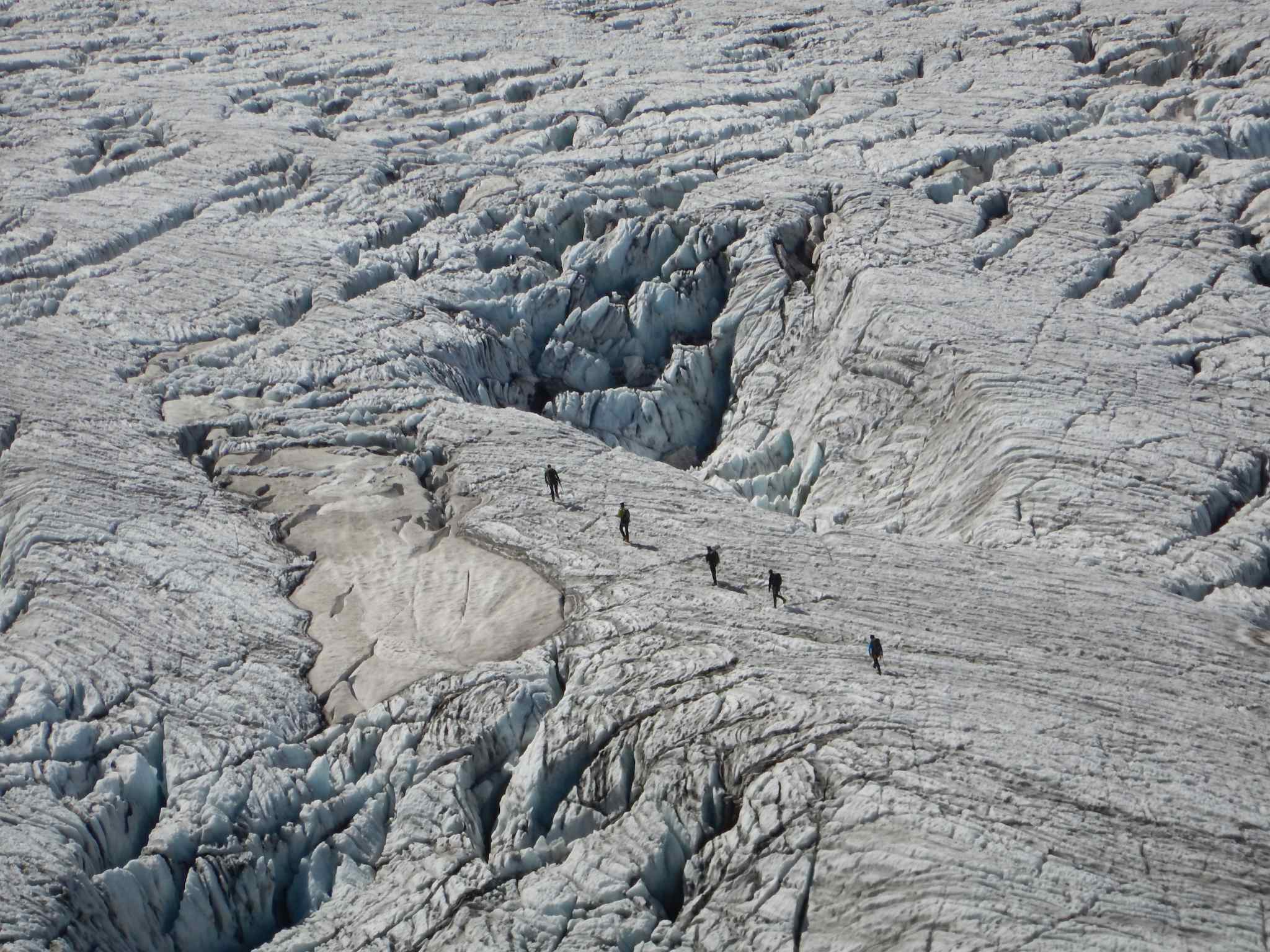
Learn mountaineering skills from expert guides as you cross glaciers and summit Tête Blanche (3429m)
Face off against mighty Mont Blanc (4805m), the highest peak in France and in the Alps, with a guide ratio of 1:2 when going for the summit
Mont Blanc’s legendary mountain huts get booked a long time in advance – so book early to secure your spot!
Looking for an alternative? Check out our trip to Monte Rosa, the Alps’ second-highest peak – an equally epic climb but without the crowds
Key Information
Day 1
Welcome to Chamonix!
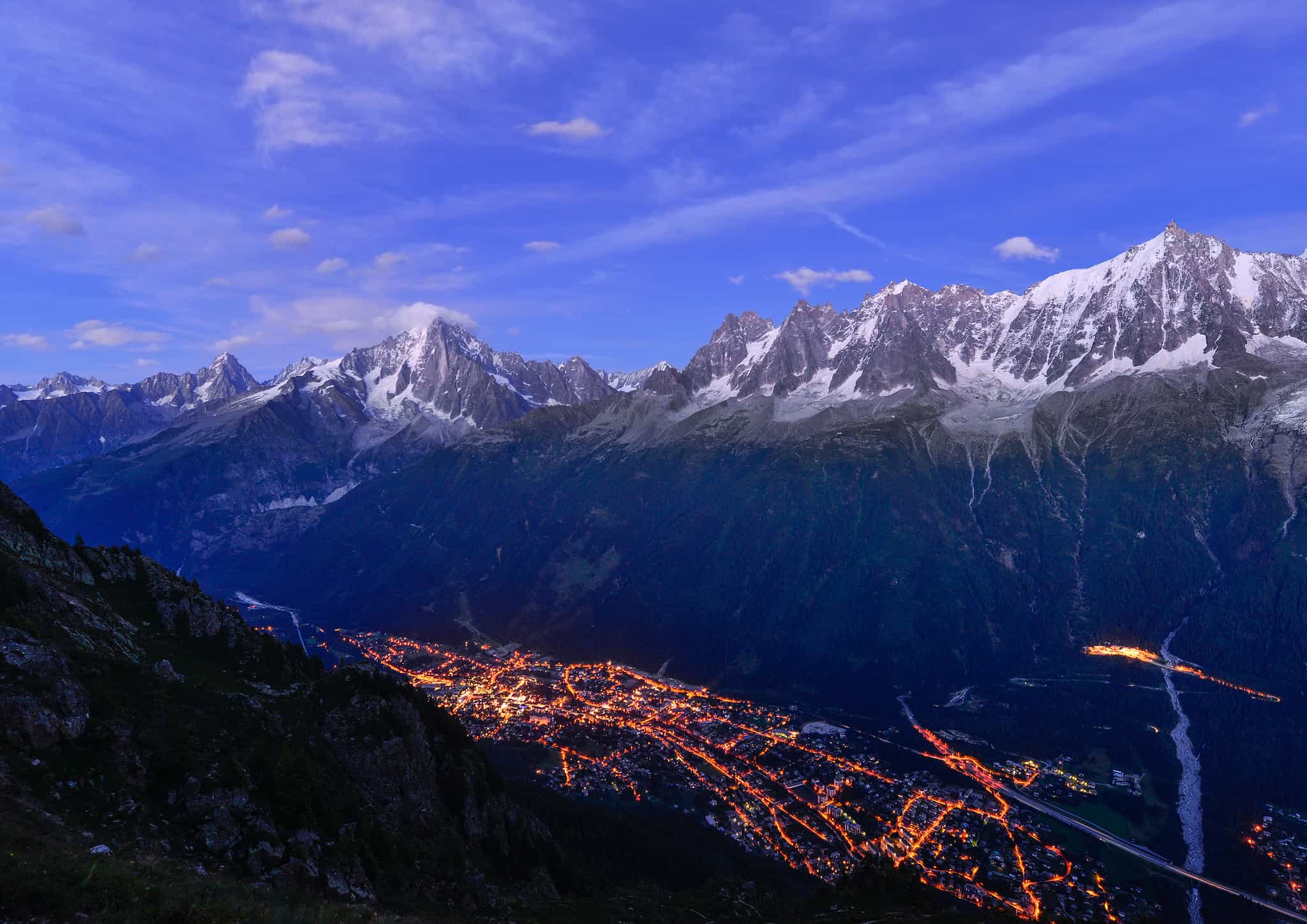
Fly into Geneva and make your way to your hotel in Chamonix in time for the evening welcome meeting. Meet your fellow climbers, get briefed on the adventure ahead by your mountain guide and check with them you have all the required kit, and then head out in search of a hearty dinner. Make sure you get some rest tonight, you've got a big week ahead of you!
Day 2
Training: a taste of mountaineering
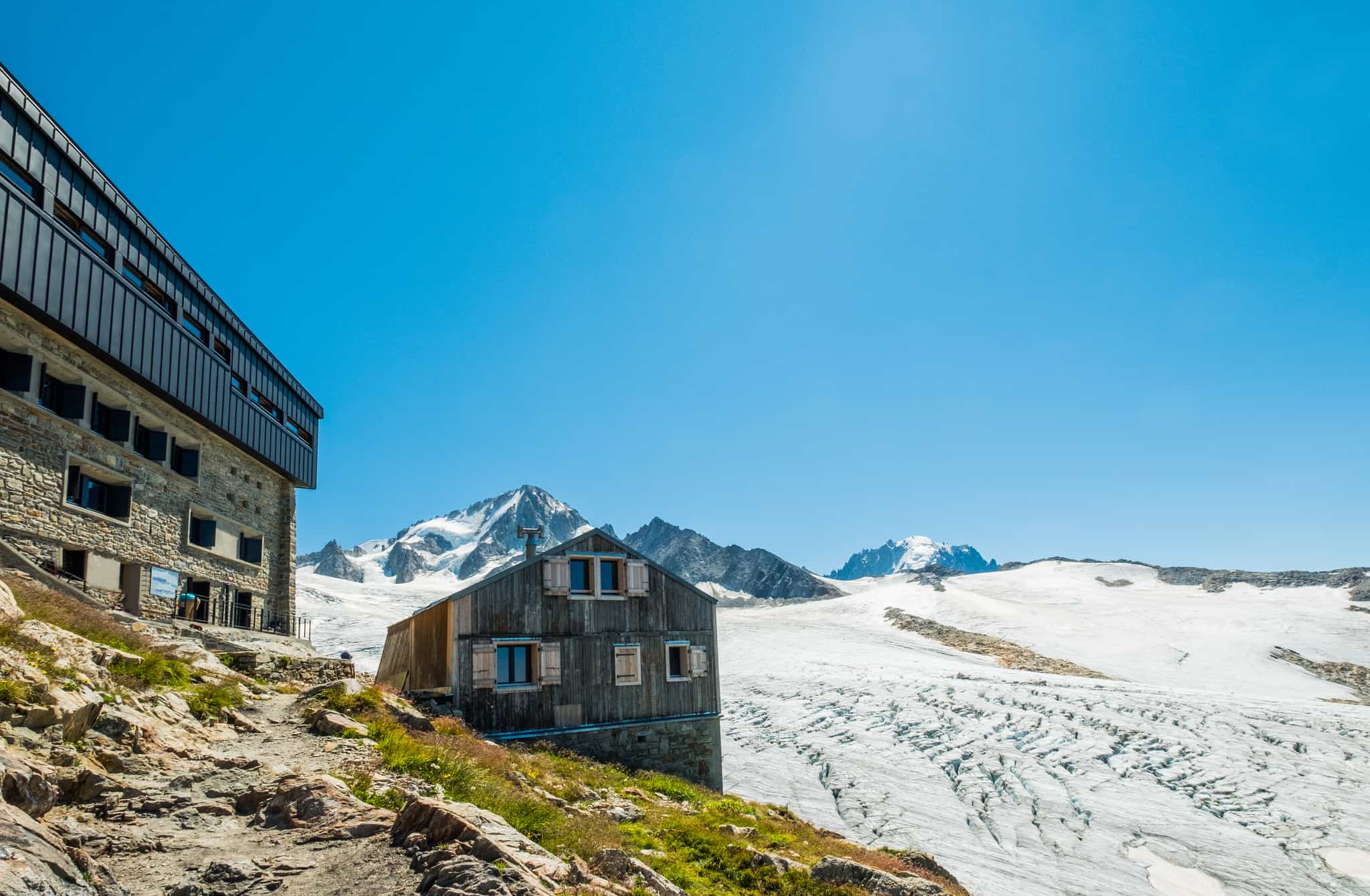
Hiking
Sort out any last-minute kit rentals in Chamonix and then head up the valley by minibus to Le Tour, from where you'll ascend by ski lift to the Col du Balme. Hike up to the Albert 1er refuge, located at an altitude of 2702m, right on the edge of the Glacier du Tour. Enjoy the stunning Alpine views during lunch before an outdoor snow and ice training session with your guides during the afternoon, to prepare you for the challenge ahead.
Day 3
Summit Tête Blanche (3429m)
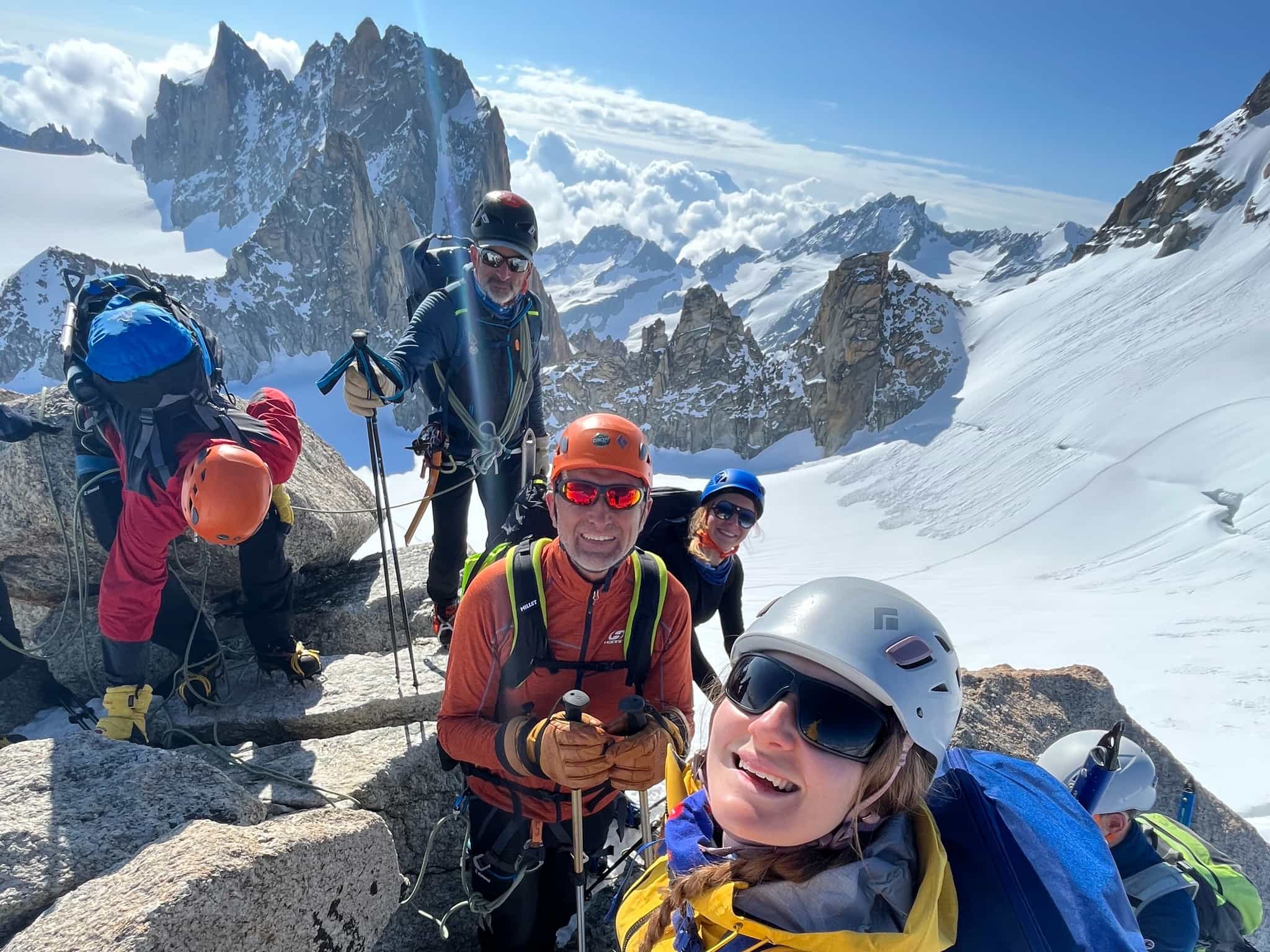
Hiking
Wake up bright and early, put your crampons on and set out to make the 700m ascent of Tête Blanche (3429m). The route to the summit will a mixture of rock and snow, with a rocky ridge-line section where you’ll need to scramble on the Aiguille du Tour – the perfect warm up ahead of Mont Blanc. You'll then cross the Col Supérieur du Tour and descend to reach the Cabane du Trient hut (3170m), in time for dinner and a well-deserved rest.
Day 4
Up and over the Col Supérieur du Tour (3289m)
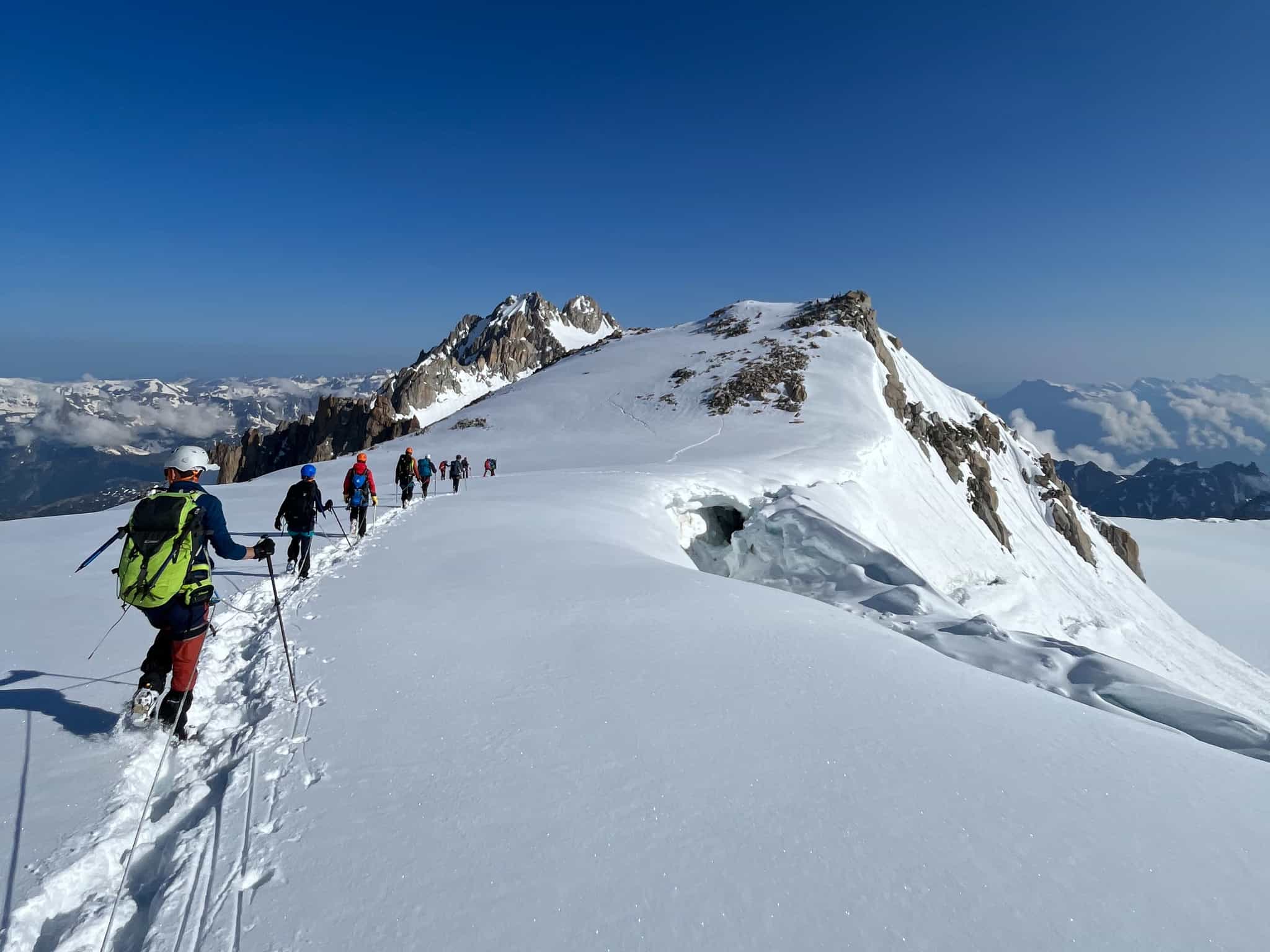
Hiking
Set out early once again, from the Trient cabin, ascend back up to the Col Supérieur du Tour. Then retracing your steps, you'll return down to the Albert 1er Refuge for a short break. From there, you descend to the village of Le Tour. Back at base in Chamonix, the guide will meet you to inform you of the rest of the programme according to the weather forecast and the mountain conditions. You're one step closer to the big one.
Day 5
Begin the ascent of Mont Blanc
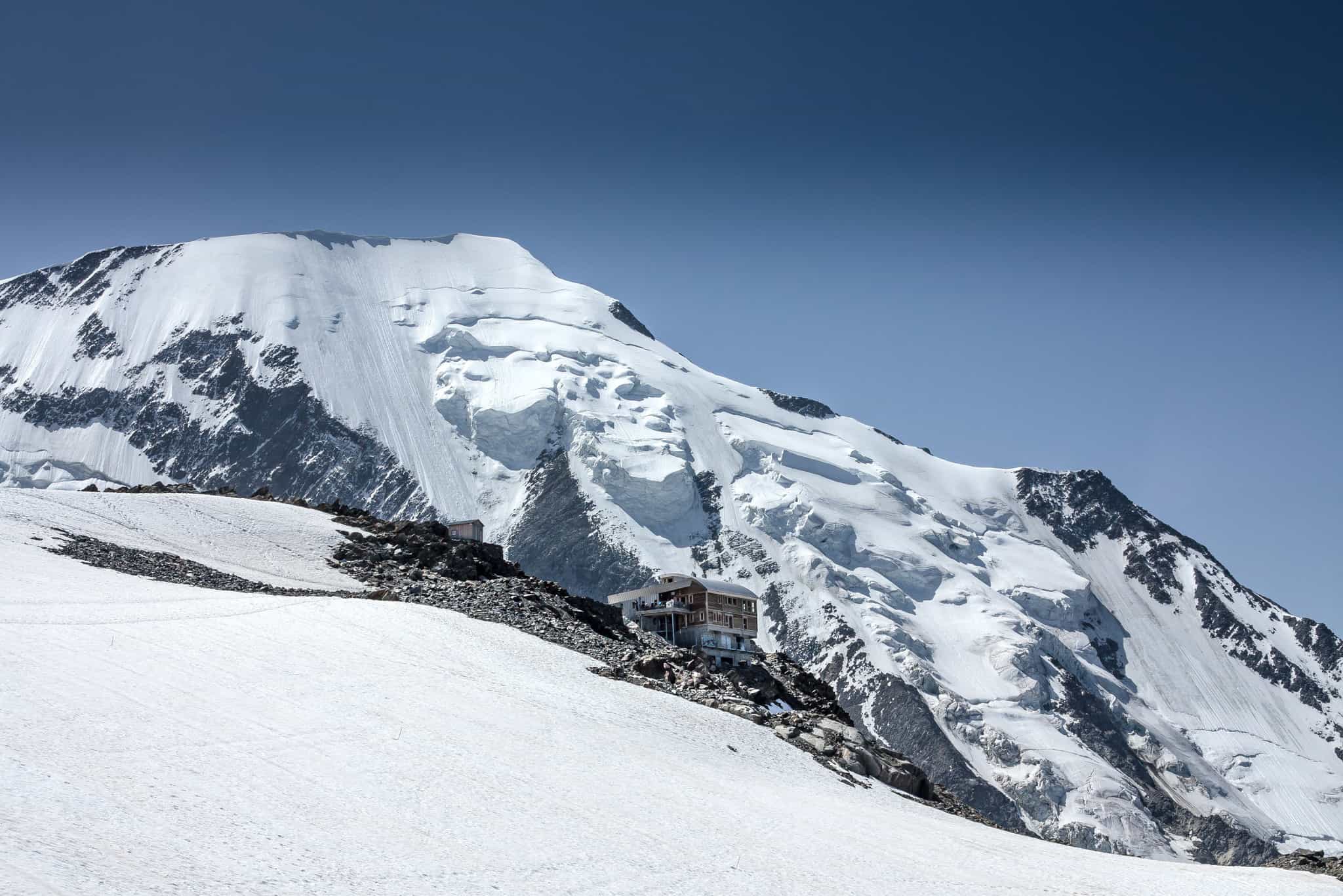
Hiking
This morning you'll head 10mins down the Chamonix Valley to the small town of Les Houches (1012m), where you'll begin your ascent of Mont Blanc. Take the Bellevue Cable Car up to 1800m, and then the Tramway du Mont Blanc up to Le Refuge du Nid d’Aigle at 2370m. If climbing in the early season, or due to technical reasons, either the cable car or tramway aren't running, your guide(s) will make alternate arrangements on this first section of the route. From the Refuge du Nid d'Aigle, you'll hike up to the Tête Rousse Hut at 3137m, where you'll rest up for the night and prepare for tomorrow’s climb to the summit of Mont Blanc.
Day 6
Summit Mont Blanc (4805m)
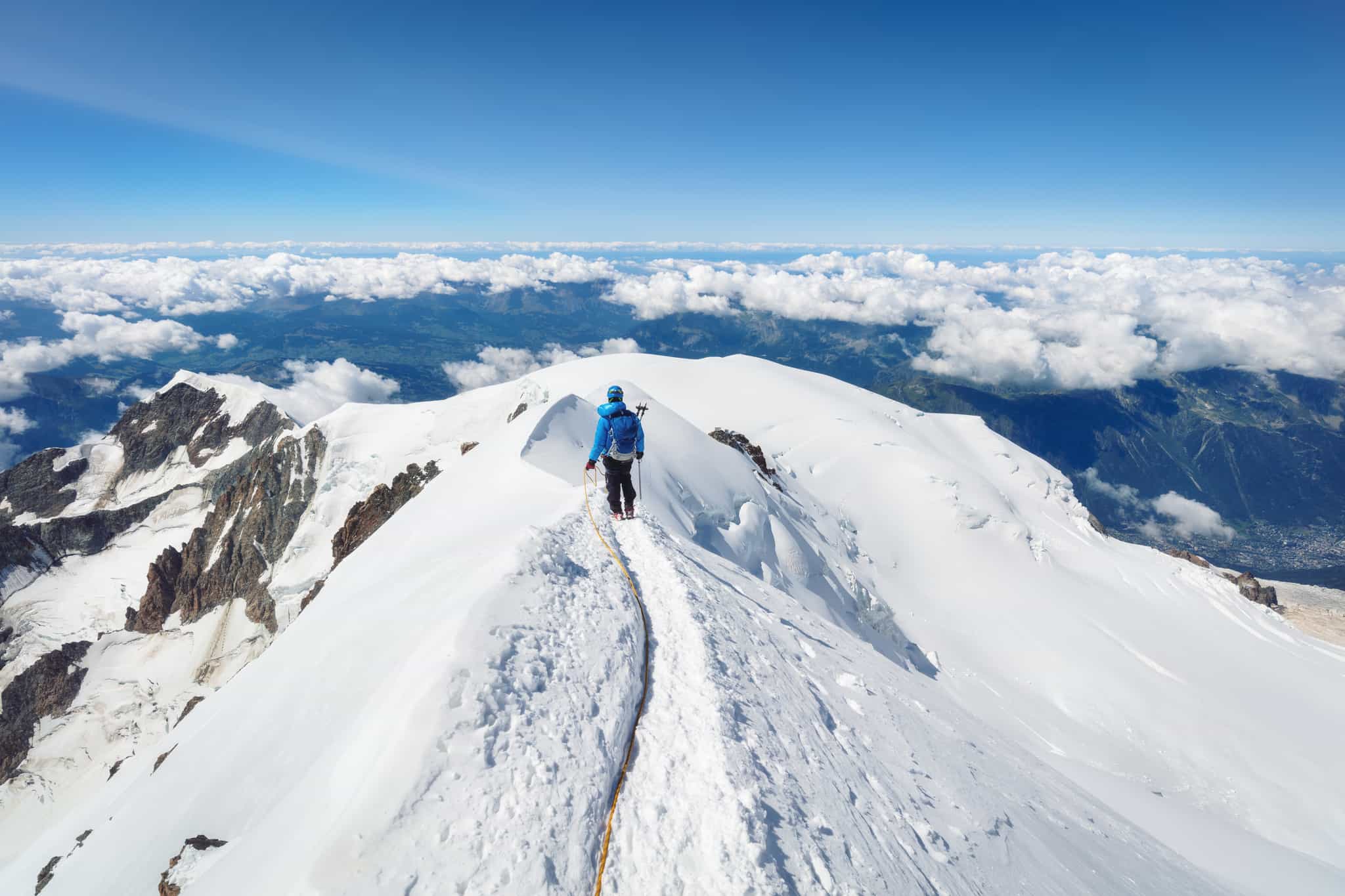
Hiking
Time to test your determination to the full! Rise early and begin your ascent on Monday, the best day of the week to summit this spectacular mountain (due to it being the quietest day). Scramble past the Refuge de Goûter and ascend the Dome de Goûter before tackling the Bosses Ridge, finally topping out on the summit of Western Europe’s tallest peak, the highest mountain in the Alps. Once you’ve sucked in that incredible view, descend to the Goûter Hut for a well-earned rest and the chance to share stories from the day.
Day 7
Return to Chamonix
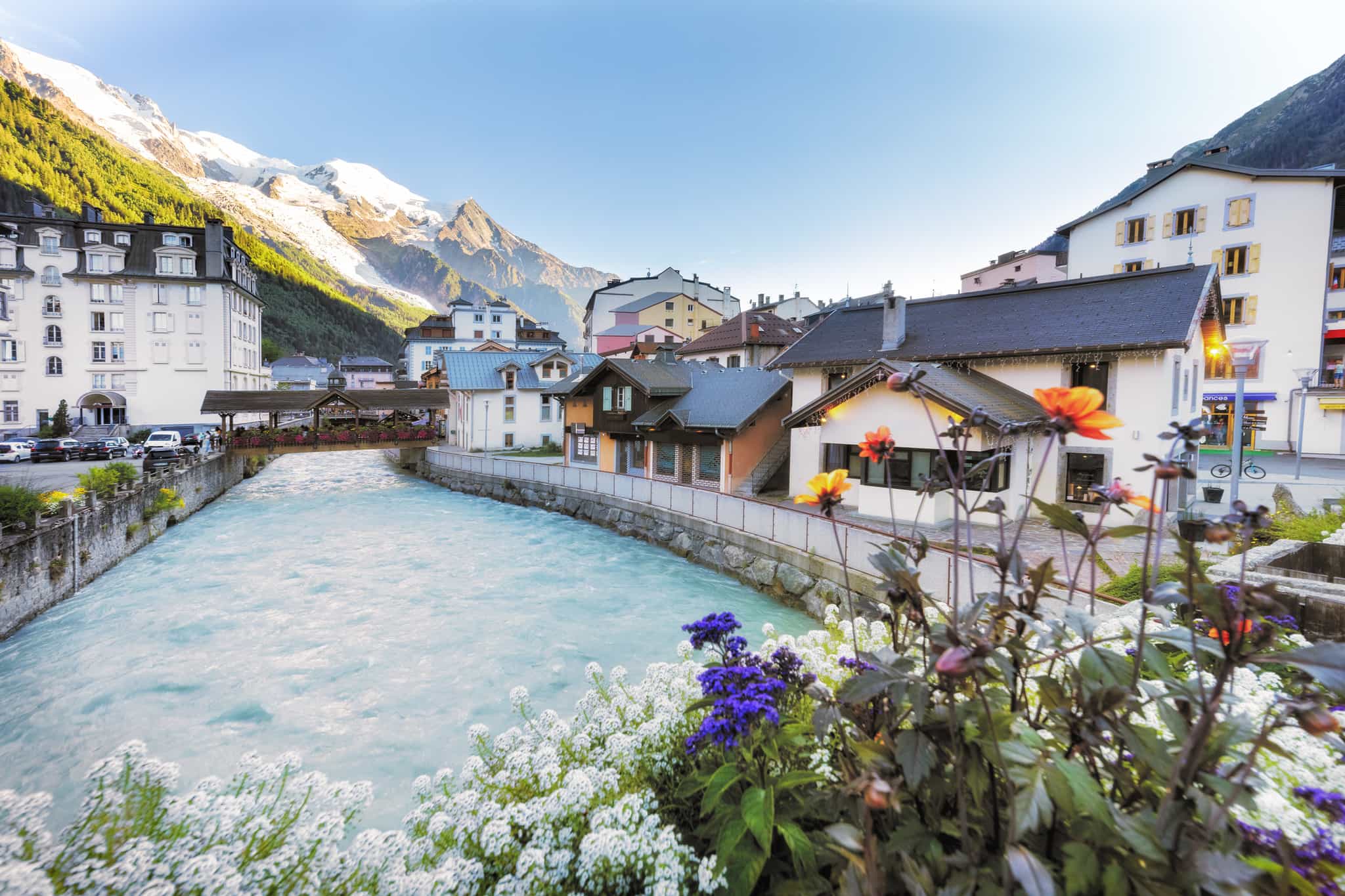
Hiking
Continue your descent and ride the train and cable car down to Les Houches, where your driver will be waiting to take you back to Chamonix. You can either leave as soon as you get back (around 17:00), or you’re welcome to stay a final night in the hotel at no additional cost. Usually, guides and guests go for a meal to celebrate and bask in the achievement of a lifetime.
Day 8
Head for home
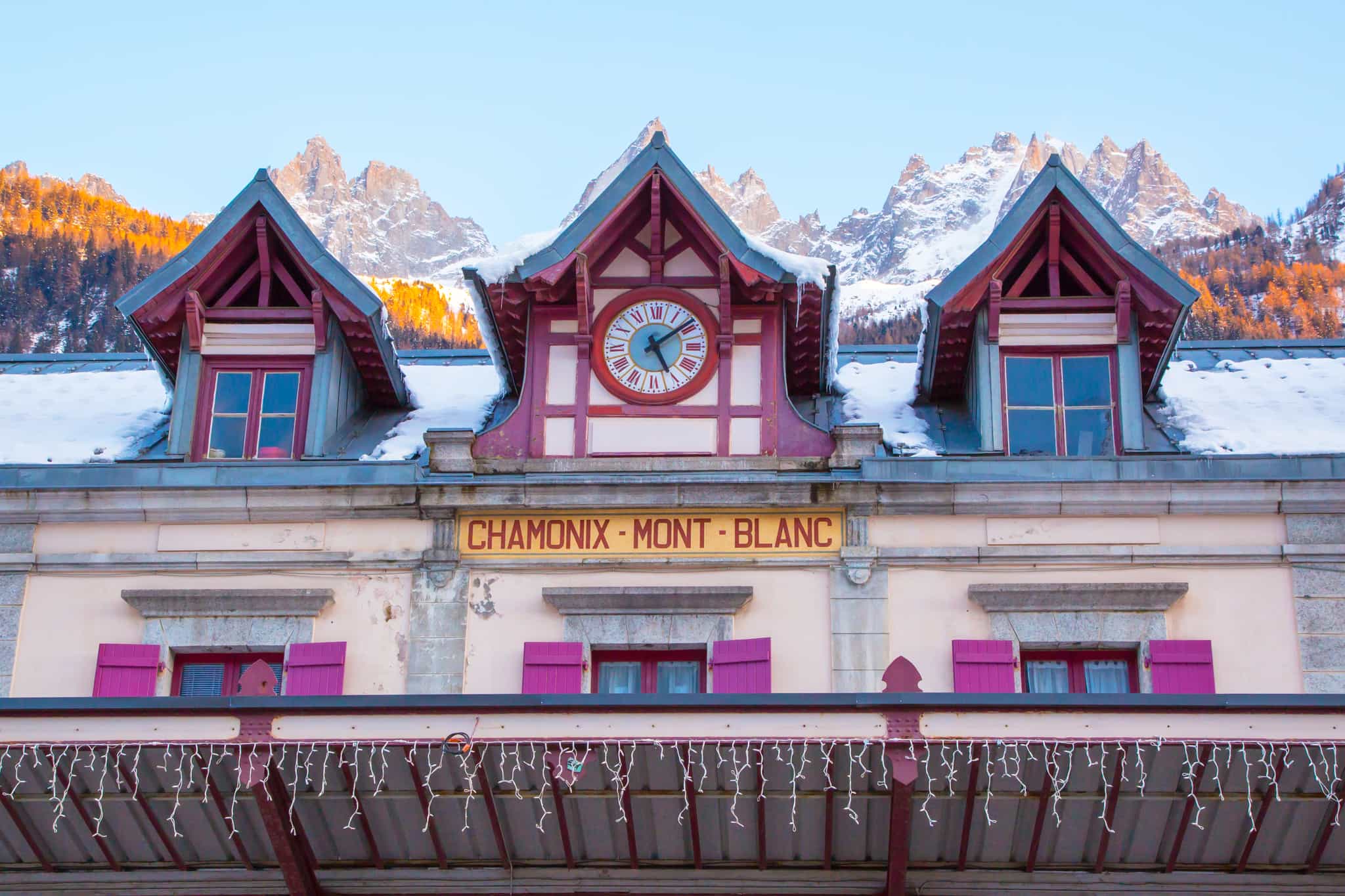
Chow down on one last breakfast before checking out and making your way back home, or on to your next adventure.
The Area
Logistics
Starts
Central Chamonix
18:00 on Day 1
Ends
Central Chamonix
17:00 onwards on Day 7, or any time on Day 8
Transfers
Your guide will meet you at your hotel in Chamonix on Day 1. You can get a choice of buses from several airports to arrive in Chamonix; alternatively, your host can arrange a private transfer from Geneva Airport if requested in advance (see the Optional Extras section for prices).
Travel options
You can fly into Geneva Airport (GVA) which is approximately one hour from Chamonix. Alternatively, you can fly into Milan Airport (LIN) or Zurich Airport (ZRH) and travel on to Chamonix from there.
For those who wish to avoid flying, Chamonix is also accessible by train via the St-Gervais-les-Bains (Le Fayet) station at the base of the valley, which connects to Chamonix Mont Blanc train station. For example, you can take the Eurostar from London to Paris and then connect to a number of direct lines (or an overnight sleeper train) from Paris to St-Gervais-les-Bains, then on to Chamonix Mont Blanc station.
You can also travel to Geneva by various train routes from other parts of Europe and travel on to Chamonix from there by bus. Geneva Bus Station is a 5-minute walk or short taxi ride from the central train station. There are various bus services from Geneva Bus Station to Chamonix, with the quickest option taking 1hr 8m.
Your return leg at the end of the trip can begin at Chamonix Mont Blanc train station for various onward train travel routes throughout Europe, or you can take the bus from Chamonix to Geneva and travel on by train from Geneva train station.
For those wanting to arrive a day early or extend their trip, your host is happy to help arrange pre- or post-trip accommodation on your behalf. The price and style will depend on availability and your budget.
Please wait to book your travel arrangements until after your mountain hut reservations are confirmed by your host, which is typically by the end of January.
Day 1
Breakfast
Lunch
Dinner
Day 2 – Day 3
Breakfast
Lunch
Dinner
Day 4
Breakfast
Lunch
Dinner
Day 5 – Day 6
Breakfast
Lunch
Dinner
Day 7
Breakfast
Lunch
Dinner
Day 8
Breakfast
Lunch
Dinner
What is the food like?
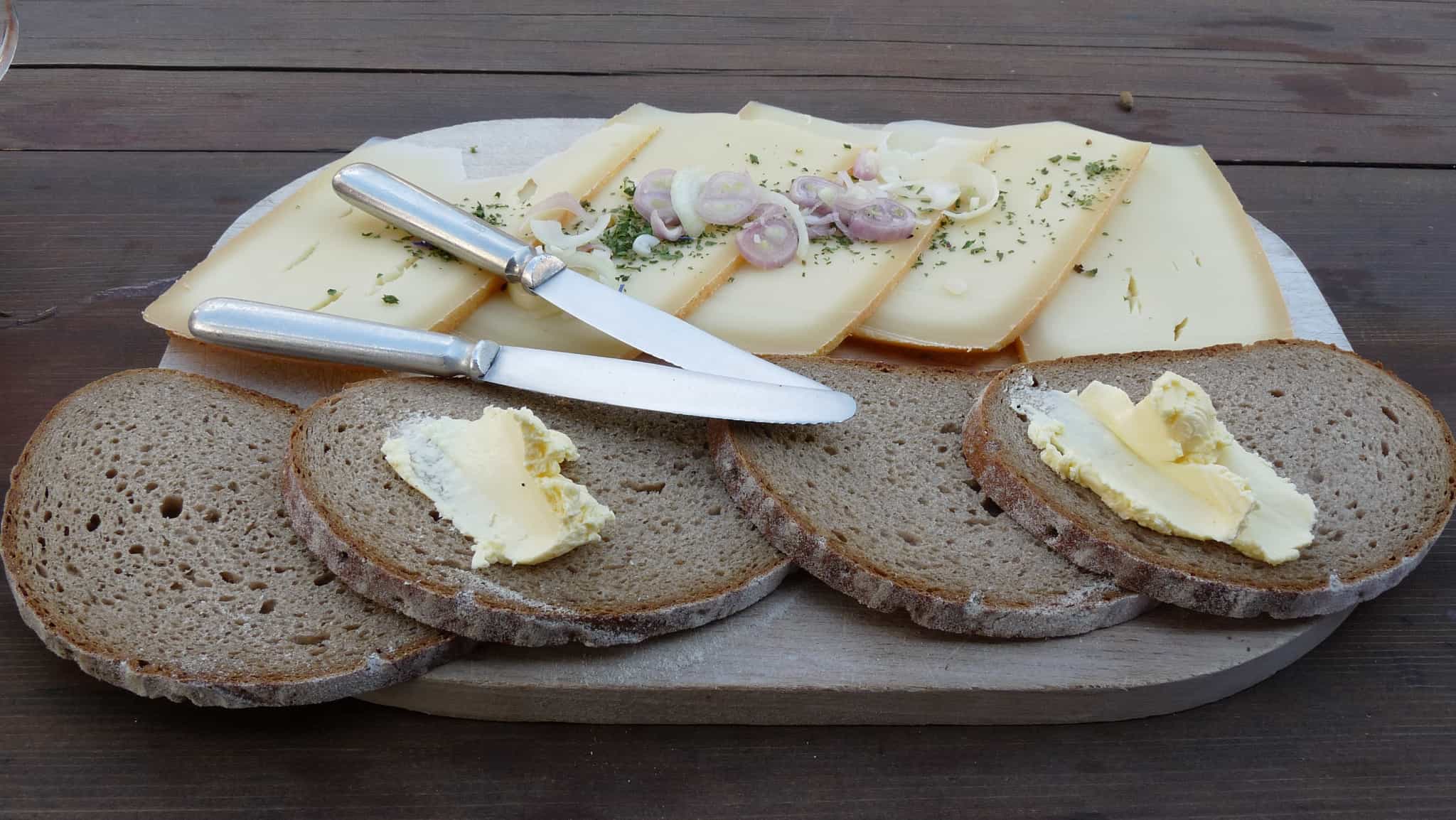
The food in the mountain huts is basic but tasty (three courses in the evening; hot drinks and bread/jam/cereal for breakfast.) You can also buy tea, coffee, wine, beer, soft drinks, chocolate bars and snacks, as well as warm lunches, in the huts*.
*Note that due to their remote locations food items sold in mountain huts are done so at a necessary premium and if you can bring things with you up from the valley that can save you money. Once up on the mountain, drinking water will need to be purchased from the huts (typically in cash) so budget approximately €5-8 per litre for this. The higher and more remote you are, the more things will cost.
Vegetarians can be catered for, but please let your host know in advance. Vegan and other dietary requirements can also be catered for but it will be basic and we recommend that you bring snacks to bulk out the meals. Whilst in Chamonix, breakfasts can cater for vegan/gluten free and dairy free diets.
What is the accommodation like?
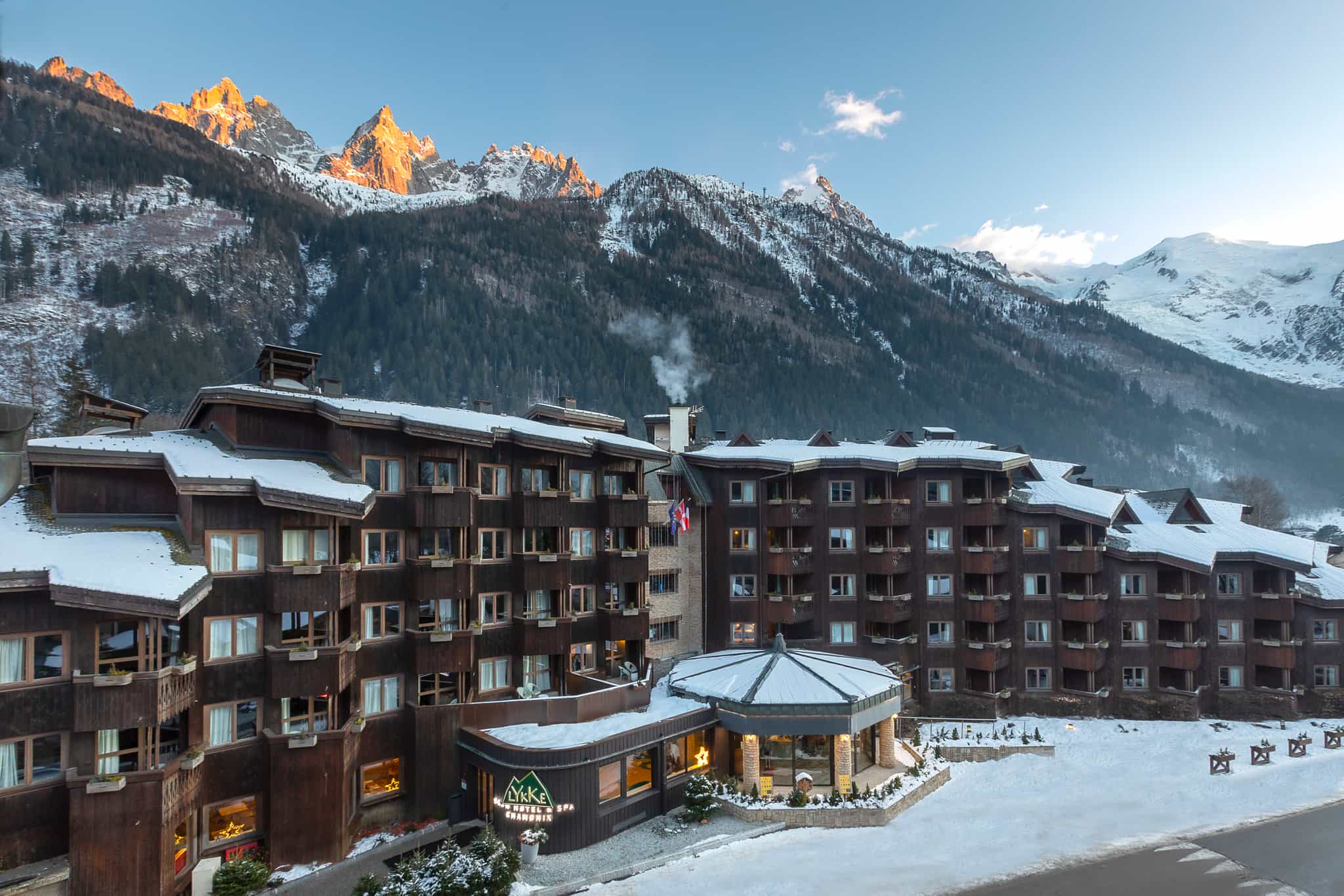
Chamonix
You'll stay in a twin-share ensuite room at a 4-star hotel in central Chamonix (such as the Lykke Hôtel & Spa, or similar). You'll be in close walking distance to rental shops, restaurants and bars. Your host will confirm the exact accommodation for your trip in the pre-departure message two weeks before your arrival.
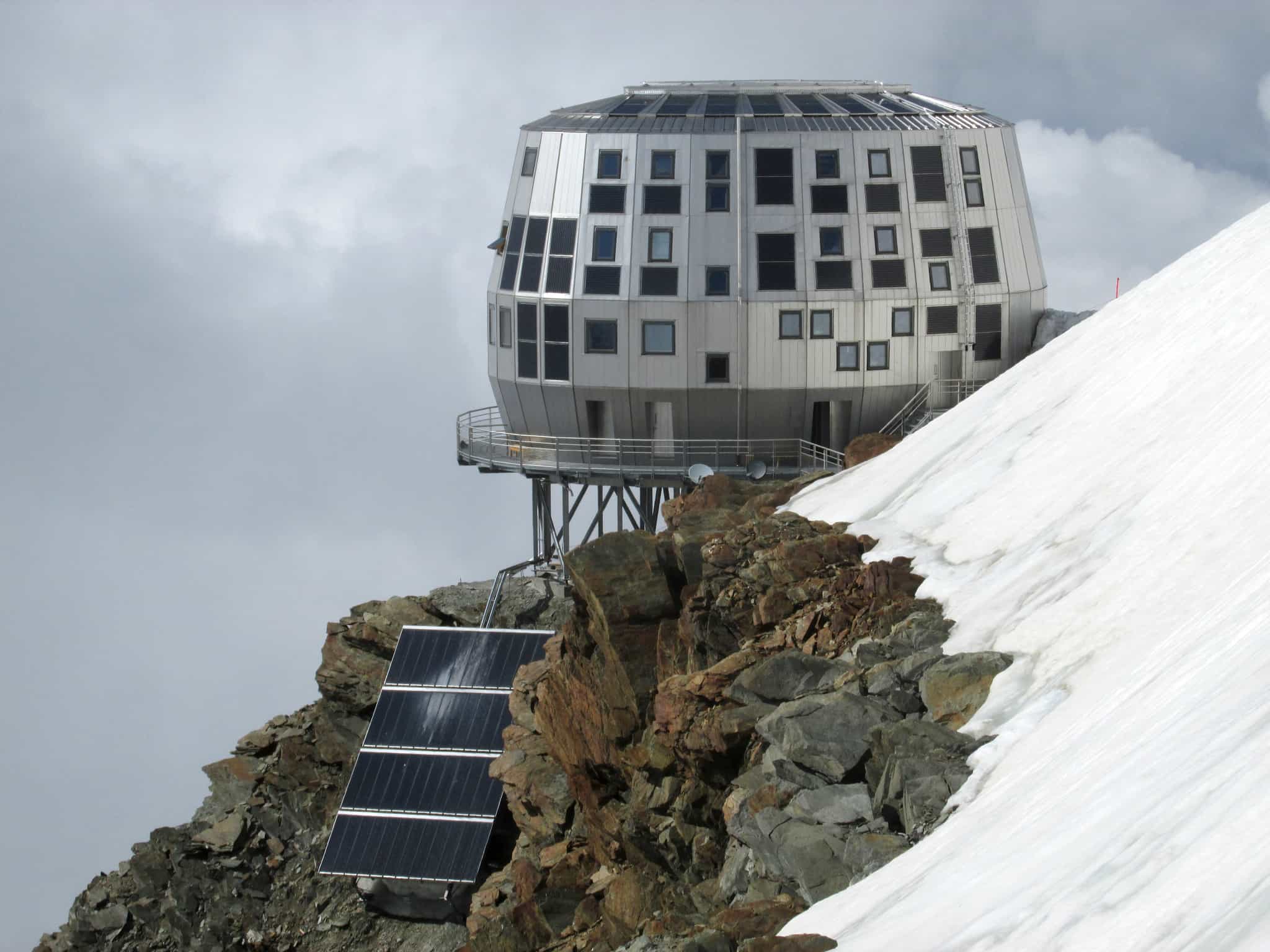
The Alps
You'll stay in mountain huts in a mixed dorm with bunk beds where you can expect a good atmosphere and a stunning view. Blankets or duvets are provided, so sleeping bags aren't needed, but we recommend that you bring a thin sleeping bag liner. There is no running water in the huts on Mont Blanc, so you'll need to buy water to drink and wash with (there are no showers).
Due to Mont Blanc's legendary status, its mountain huts get booked up well in advance. We suggest booking your climb before the November prior to your trip, so that we can secure your space.
Upgrades
For solo travellers looking for their own space, an optional private room can be booked for the three nights in the hotel in Chamonix for an extra charge – see Optional Extras for the price. Rates shown are for the current climbing season, next year's prices will be available soon. Please request this at the time of booking (this is subject to availability).
It is not possible to have private accommodation in the mountain huts.
This trip has been rated as Tough
Climbing the highest mountain in Western Europe is a big goal to aim for, suitable for those seeking to test themselves in a high alpine environment. The summit of Mont Blanc is 4805m high; the altitude and the amount of vertical ascent and descent on snow, ice and rock demands the respect and preparation of every mountaineer.
Whilst previous technical mountaineering experience at altitude isn't essential, and training on fundamental mountaineering skills (such as walking with crampons whilst attached to your guide with a rope and how to use an ice axe) will be provided by your guides during the preparation phase on Days 2-4, realistically, the more mountain experience you have the better your chance of making the summit.
Regardless of experience, you need a high level of cardiovascular endurance, all-round fitness, a can-do attitude and plenty of determination. At a minimum, you need to be able to hike comfortably with a heavy pack - carrying your technical gear plus food, water, and extra clothing - for up to 12 hours at a steady pace. This trip has been rated at the top end of our difficulty scale for good reason.
Climbing Monte Rosa is an ideal way to prepare for a summit attempt on Mont Blanc.
What will I need to carry?
You will need to carry a 30-50L mountaineering specific pack, with ice axe loops/straps, containing all your clothing and personal items, sufficient for several days up high sleeping in mountain huts. It's very important you bring or hire the correct equipment. Please read the Kit List for more details.
In short, alpine and prone to change, so you'll need to prepare for all weathers and dress in layers. Put it this way – it’s called the ‘white mountain’ for a good reason. The climbing season runs from mid-June to late September and between those dates there is no better or worse time to attempt the climb. The beginning and end of the season can be snowy/ cold, and the middle months can be busier and the hotter temperatures can cause afternoon storms.
Summit success varies from season to season but remains consistent throughout the months. If the weather shuts you down, your host will endeavour to find the closest mountain in the area with better weather and thanks to their base location they are generally able to find an equally beautiful alternative within driving distance in France, Italy or Switzerland.
POSITIVES AND NEGATIVES – EXPENSIVE AND POOR CUSTOMER SERVICE
I went on the trip in early July 2025.
Due to bad weather we were unable to attempt Mont Blanc. This clearly couldn’t have been avoided and instead we summited Gran Paradiso. I am very pleased and grateful to the guides that I achieved my first 4000m+ summit. In doing so, for me this was far more a mental challenge than a physical one.
Positives – This a great adventure! The scenery is absolutely stunning, and my favourite part of the trip was the hike up to Tete Blanche on Day 2. Our main guide (Phillippe) had decades of experience and taught us the required mountain skills really well – even if he was a little direct at times! He also encouraged us to try some ice axe climbing which was great fun and really helpful. I felt completely safe throughout. We had an additional guide (Ricardo) for the Gran Paradiso summit. Due to poor weather on Day 5 instead of hiking the two guides gave us a ropes and rock-climbing session (which is not included as part of the standard itinerary). This was really great and I found it so helpful at the top of Gran Paradiso as there are ledges with sheer drops either side and I have acrophobia – I really want to thank P and R for their encouragement in this section! I really conquered my fears by understanding the safety of the rope! The Refuges were well run and provide a very convivial environment for the team and guides. Please note that they provide crocs – so need to carry sandals.
Negatives – Phillippe advised us on Sunday evening that Mont Blanc would not be possible. We did not hear from MBA or the local agency at all regarding the options available. Instead, Gran Paradiso was presented to us by Phillipe as the only option. I would have preferred to tackle Monte Rosa – as more comparable with MB – or been advised on whether a partial refund was possible. Gran Paradiso is still 4000m+but IMHO it is a boring hike as you walk up from Pont and then walk back down to Pont – there’s no variation aside from some scrambling – just up and down. The actual summit presented a mental challenge for me – but not really a physical one. Regarding the Refuges – the local agency seemingly just books clients into the cheapest beds available. Days 1 and 2 we were in three berth beds (when there were several rooms with just one bunk of single beds in them), and Days 4 and 5 we were in the worst room in the refuge with a temperature barely above zero degrees. The guides were fantastic but they asked nothing about our fitness or prior training and we were repeatedly told we were ‘low energy’ (i. e. low fitness), yet my average heart rate summitting Gran Paradiso was 107 – hardly high!
Expensive - The trip we did was not worth the £3000 + we each paid. Many companies offer a Gran Paradiso summit as a three- day trip alone for c€800. Next time I would book directly with a local organiser or guide.
Poor customer services – Comms with MBA and the local agency were non-existent throughout our trip. This was really poor given that we were advised on Day 3 that we couldn’t attempt MB and didn’t know our available options. The only contact we had from the local agency was on our arrival back from Gran Paradiso when they met us in the hire shop. We were told this was a feedback session. However, the real reason they showed up was because they wanted our input on a dispute between a team member who had been helicoptered down on Day 2 and the guide/agency as to the necessity of that. The local agency showed little interest in our experience and didn’t express any sympathy that we had not been able to attempt Mont Blanc. An entirely self-serving approach.
Overall I did have a great week – I had a fab team, fantastic and fun guides, I learned loads technically, and the scenery is just spectacular. However, Days 1-3 and the GP summit were for me far more of a mental challenge than a physical one, and the service provided by MBA and the local agency was underwhelming.
Live affirming but not for the faint of heart
First off let me be very clear, this is NOT a trek! It is mountaineering. Mont Blanc is to a Trek as the London Marathon is to a gentle jog around the park. Yes there are elements of trekking along the glacier, but they are accompanied by sections of grade 1, 2 and in some cases grade 3 scrambling. Once section requires via ferrata and on occasion a bit of belaying by the guide.
This was a truly epic adventure. Mont Blancs challenges isn't so much its height, as its sheer force of nature and the many different types of climbing styles experience it offers.
You need to be physically fit, not super human fit, but have a good level of fitness and training is required to build endurance in the legs as well as cardio. Climbing experience isn't necessary as the guides are very experienced and will make sure you get through the more technical elements of the climb. But fitness is key to being able to summit. Mental fitness as well as physical. (there will be moments when you question your life choices!)
Solid mountain boots ARE required from the first day. There is no need to start in lighter boots or approach shoes as your start height is pretty close to the tougher areas, so wear your big heavy Herman Munsters from the get go!
You will spend an awful lot of time in crampons which change the way you walk and operate (crampons are the destroyers of gaiters!)
Good poles are also a must, your knees will thank you on the ascent as well as the descent.
You can hire the kit you need, but for the relatively low cost of crampons I'd recommend buying them, if only because the hired ones have been well used and the spikes a little less sharper, and in some sections you'll be very glad of the spikes being at their sharpest! (you can always ebay them afterward)
This is a mountain in every sense and she will throw everything at you, including unpredictable weather and high winds. Make sure you have a good outer shell jacket and trousers and where possible cover your face as much as you can if caught in high winds. Wind burns aren't fun and 4 days later, half of my face is still falling off!
The refuges are a reasonably good standard and pillows and duvets are provided and the food is plentiful and pretty good when you consider where you are. Some take card, but bring cash. A 1L bottle of water is about 7 euros and while some have running water in their toilets, it isn't drinkable so you will need to buy 2/3 bottles each day.
There are toilets in all the refuges for all your business requirements when nature calls, the "step flush" is a particular highlight for your numbers 2's. . . . .
A 50L pack is ample for what you'll need and you wont need much. We took spare trousers and base layer, mid and thermal layers, hat, couple of pairs of gloves (over mitts are the key for operating at height) something light and easy to change/sleep in at the refuge, a change of underclothes and socks and a few snacks (although you can buy Snickers/Mars Bars for 5 euro at the refuge). Also bring polarized glasses if possible, if the sun is out the snow is very bright and you'll need them. And of course sun cream and moisturiser to prevent yourself from going full tilt "Goldmember" (Itsh a keeeeper!)
All in all, this was a fantastic adventure, everything is taken care of by the local team on the ground, the hotel in Chamoinx was excellent and very comfortable with a great spar and more outdoor gear shops to satisfy even the biggest kit monster and its all priced pretty evenly.
We hired a car/mini bus from Geneva airport so we had a bit more independence in planning our arrival nd depature and there is a car park under the hotel where you can leave it. You can also leave your bags with your extra stuff in at the hotel for 5 euro a day so you're only going on the mountain with what you need for the 2 nights and 3 days on both the acclimatisation phase and the Mont Blanc phase.
If you want a challenge and to achieve something that will live long in the memory then this is the adventure for you. Its hard, there will be a few dark moments when you're questioning your sanity, but it is absolutely worth every step, pull, push and teeth gritting crawl forward.
And when you summit, I challenge you to not have a lump in your throat and small tear in your eye
Definitely not the cheapest option
I went on the trip at the start of September. Due to snow and a hut closure, we were unable to attempt a summit of Mont Blanc.
This was clearly out of anyone's control and the guide did a great job ensuring we still had a fun trip and other summits. The trip we got, however, was not worth the amount we paid. Next time I would book directly with a local agency, or a guide.
To be clear the trip was good and the guide was fantastic, but there are definitely cheaper options out there if you're looking to summit Mont Blanc.
Hi Toby, We regret that your trip coincided with extreme weather conditions, which rendered the summit of Mont Blanc unsafe to climb. Unfortunately, the usual alternative options, Monte Rosa and Gran Paradiso, were also unavailable—an unusual occurrence where all three routes were inaccessible simultaneously. Despite this, thanks to the expert knowledge and strong local connections of the guides, your local host in Chamonix arranged an alternative plan and your group was able to climb up to Dômes de Miage via Refuge des Conscrits, ensuring you could still enjoy a high-quality alpine climbing experience. This adaptability and commitment to customer care are central to the value offered by our local hosts. Your feedback has been shared with the host to help improve the quality of future trips. Thank you. James, Much Better Operations Team
Did Gran Paradiso due to weather
Sadly, did not get to summit due to weather, but still a great time in the Alps, crossing glaciers and seeing great views.








Epic doesn't come close! Summit complete
It's hard to put this trip into words! I knew when I booked it would be tough, and I wasn't wrong... without doubt THE hardest thing I've ever done, the summit day was both physically and mentally exhausting. But hard things are the BEST things right?!! The biggest thanks to our main guide Pierre who got us working together as a team over the week. He taught us how to use our equipment and made sure we were always safe and spurred us on! We couldn't have reached the summit without the addition of 2 more guides, Luca and Alex. Their calm experience and constant encouragement was invaluable. If you are thinking of booking this trip, make sure you do the training (the Internet has all the info you need), and test yourself at altitude first if you can. 2/6 of our group could not summit because of the effects of altitude, and the trip itself doesn't have huge amount of time for acclimatisation.







I'm ready for Himalayan Mera Peak.
Massive thanks to our guides Patrick and Fred and my group Jen, Tom, Loui, Graham and Mark for company. My first summit over 4000m. Amazing experience in France, Switzerland and Italian Alps. Hope I'll be ready next year 6476m summit 🙏🫶



Successful summit of Mont Blanc
Experience of a lifetime! The guides were absolutely outstanding getting us to the top of Mont Blanc in 60 kmph winds. The acclimatisation trip provided a great opportunity to practice walking in crampons and the technical skills of using an ice axe, so no prior experience was required. My top tips: you can rent boots there which are crampon compatible, there are crocs at the huts so don't need to pack sandals and bring a thermos for the summit day as the hut will fill it with hot tea!
Mt Blanc
It’s a good trip. It’s safe, the guides are competent if maybe a little conservative. It is a tourist operation. They do not teach much they basically rope you up and say follow me. As an example, in my group only three of us had ever held an ice axe before but there was no instruction on how to use it or the best way to carry it and not a word about self arrest. They did give my group some basic crampon instruction on a glacier. I would give the company a C- on communication. I had a couple of unanswered emails/ texts or long delays on responses.
Having stated the above I did enjoy the trip. The scenery was magnificent, the huts were comfortable and well stocked. The guides we competent if overly conservative as previously stated. At the end of the day they did deliver on a safe attempt to summit Mt Blanc.








Mont Blanc Summit
I loved this trip and had a successful summit. Be prepared for things not to go to plan and very changeable weather patterns. Make sure you give yourself best chance of success and control what you can. Train hard, don’t just buy the equipment, use it. Get out into the hills if you can. I had a last minute boot hire in Chamonix, to B3’s because weather unseasonably cold. If I had to do it again I would have bought these and worn in myself. Created a bit of anxiety wearing boots never used before. The landscape is breathtakingly beautiful. The days ahead of summit provided good time to gear check and warm up. Guides were on point.
Review of my trip
Hi, I booked the trip in December 2023 and advised the company I had one leg. It was transparent that this was going to be a first for all of us and it was very much lets see how it goes. I had a call with Dan Moore our guide a few weeks before and he was up for the challenge. an above knee amputee climbing Mont Blanc is not for the faint hearted. When my friend Steve & I arrived at the hotel we were met by the French version of Basil fawlty! Brilliant all added to the experience. We then met the team and Dan and other holiday guests. Lovely people. Dan talked to me at length to gain an understanding of my leg and what we were doing and it was fair that he took me under his wing and the other 3 would be with another guide. On the first night I didnt sleep very well. I had stomach ache as eating the wrong foods on the ferry. Nonetheless, i thought no more of it as we were supposed to only do 500 metres. Unfortunately the lift was closed so we hiked up 1,300 metres to the Premier hut. I could not have been slower as what was only supposed to take a few hours took 8 or so hours. Dan supported me the entire way. He exampled leadership, teamwork, safety and kept up conversation. We were both shattered by the time we got to the hut as there were hours of focus. We had a laugh and it was clear to me that his knowledge of the mountains was second to none. We had dinner and then an early night as I was tired and requested the following morning off. We hiked that day through sun, rain and snow, but we all still had smiles on our faces. Everyone seemed happy and the other guide was a little less confident if not shy. On the second day I said to the other guide, why are you so noisy? He looked at me bewildered, so I explained that he need to come out of his shell. He received the feed back from with grace and I believe dan had a word with him and he actually made a constructive effort to be more communicative. Great. Next day we left early as the bad weather was coming in. The abled bodied went with xandro and i went with Dan. We slid down on my butt for 300 metes and I got down in a fair time. Dan and I had discussions about the realism of me reaching the summit of Mont Blanc. First there was the weather forecast. It looked very poor and it looked as though it would be called off. Then it had to be safe. I accepted that I would not do it this time unless the train suddenly came on and the weather changed, Dan warned everyone and it was accepted that they would try and Dan would monitor the forecasts. When Steve & I got back to the hotel we went to our room. We were buzzing. I established that the other chaps were not happy as their room was not ready - I believe they met Basil Fawlty - it all adds to the experience. We cleaned up and went downstairs to meet Dan. I felt for Dan at this meeting as he was being the go between for the company and the other guides. I was told that I would not reach the summit but I could have a go at getting to Tete Rouse hut or we can go to Monta Rosa. I'd never hear of Monta Rosa before - so a quick call home and we agreed I would do Monta Rosa, safer, still a challenge and my plan had to adapt. I am really grateful to Much Better Adventures and more importantly Dan for making this happen as you could have said stay in Chamonix. I said to my friend that he could go with the others or come with me - the choice was his - he decided to come with me. The others - they were reactive at the news that it was not recommended that they do Mont Blanc due to the forecast. it was explained clearly by Dan that reaching the summit was nominal due to incoming snow, rain and risk of rockfalls etc. He said that he spoken to the other guides of 20 years plus experience and they were adamant that summiting would not happen but they could still try. Dan took a lot of flack from the other three and I think this was unfair on him both in terms of how they spoke to him and that the company expected Dan to deal with it. Nonetheless, dan did deal with it and arranged everything. I know he is not employed by you and I think in the future it would be good practice to have a rep from Much Better Adventures to support the guide if bad news has to be delivered. Quite simply, they were just upset that they were not getting what they had paid for. Dan made it happen and the gratitude he received from them was nothing. Steve & I thought he handled it well, and it was given the go ahead, even against everyone's advice. I recall the chaps saying - i dont care if i dont reach the summit I just need to know I tried. They all agreed to that affect. Dan advised that he'd pick them up first thing take them to the lift and then come back for Steve & I. He collected us outside our hotel and off we went. arriving at Monta Rosa, we got the lifts up to be greeted by another snow storm. Along the way, there was a minor snow slurry. Dan sorted it and got us to the hut promptly. Dan was and is such a compassionate human being. He took the time to explain everything, kept me safe, we talked about everything and anything. The conditions for me were not great. The snow meant that every step collapsed through 4ft of snow. He knew I was struggling and began to walk like me to see how much effort it was taking. I appreciate that as he really took the time to understand my disability so we could adapt. We reached 4,000m and I was done when my friend threw a snowball in my face. I had had a fall and my stump was in a sore way. When I declared this Dan came over, fist pumped me and gave me a massive hug - he was so proud of what we had done. We went back to the hut, tired and relieved but we had all become solid friends. Next morning we left at about 6 am to get back down. The snow was frozen this time and in these conditions I know I would have reached the summit of the peak we didn't. Never mind - its about the journey not the destination. ON the way down there was a problem. The path had been demolished by an avalanche. Dan had to perform an emergency stomper, with Steve going first. Never shit myself like this before, but I am so glad this happened. Dan was in control and explained everything beautifully. We did as he said and being a left leg above knee amputee I went down 7-10 meters on 3 limbs and a prosthetic. This was what this was about. Obviously I was disappointed about not doing Mont Blanc. However, this trip was a learning curve educating me what I need to do to reach the summit. Dan is direct. I asked what I need to do to reach the summit of Mont Blanc and he told me. I love the fact that the does not tell bull shit as this makes him a genuine person, a good friend and an excellent guide. Some people can't handle being told the truth, but if they are not told the truth and live under an illusion they are just setting up the situation to fail. Dan will put in the hours to make sure his entire party is safe. I witnessed him go out of his away to make sure all the parties needs were met, that they were happy and most of all they were safe. In my opinion he went over and above the call of duty. I am that impressed with Dan that I am arranging a team for another go of Mont Blanc in September 2025 and I want Dan to be my guide, because I trust him and i know he will always have my best interests at heart. Improvements - we didn't find out the hotel location until the day we arrived. No drama. I treat this whole trip as a learning curve - i/we learnt a lot. All I can say is thank you and do please look after Dan. He represented your company in a really good manner on the Saturday and unfairly took a kicking from the others on your behalf. He's a great guide and I will certainly recommend you and him to all friends. I will approach you for the next tour but I have only been back a week so still processing that I reached 4,000meters and did an ice wall. I have plenty of photos which I will send via we transfer if you want them. Best, Chris Linnitt PS - when I was exhausted Dan gave me his last plumb and his plumb tasted gorgeous! :)
Mont Blanc unsuccessful attempt
What an amazing experience! The Alps are beautiful! The guides were fun and encouraging when things got tough.
Due to the Tramway not running we had a very long day to get to the Tete Rousse hut. Then starting that low for a summit attempt is a long very difficult day for an average mountaineer. This itinerary is not set up very well for success unless you are a very strong athletic mountaineer. These distances and elevation gains are tough for an office working, weekend mountaineer.
Lastly as a weekend climber I was hoping to pick up a few tricks of the trade from the guides but they really didn't share much, I learned a few things through observation but not much that I could add to my skills list.
The people were fabulous! Truly remarkably wonderful!! They made us feel welcome and cared for our needs - truly amazingly awesome!
Organisation was great.
The huts and organisation was good. Both summits gave perfect timing to learn, rest. Excellent trip
The level of experience I gained was great.
Itinerary Activities
- Hike and training session by the Glacier du Tour
- Guided summit of Tête Blanche (3429m)
- Hiking ascent of the Col Supérieur du Tour
- Hike to the Tête Rousse Hut
- Guided summit of Mont Blanc (4805m)
- Hiking descent from the Goûter Hut
Guides
- Expert, qualified mountaineering guides
- During the preparation phase of the trip, the guide to climber ratio is 1:6
- During the Mont Blanc summit attempt, the guide to climber ration is 1:2
Accommodation
- 4 nights in Mont Blanc's iconic mountain huts
- 3 nights in a hotel in Chamonix
Meals
- All breakfasts
- 5 lunches
- 4 hearty Alpine dinners
Transfers
- All transport between locations from Day 2 to Day 7
Equipment
- Blankets or duvets are provided at the mountain refuges
Our trips are hassle-free by design. We include all the activities and equipment, as well as many of the meals, so you can simply rock up with your rucksack and share the adventure with your new pals.
Travel to and from the trip
Our trips do not include flights, trains or other travel to the start point and back from the end point.
Airport transfers
This trip begins and ends in central Chamonix, so you'll need to make your own way there from the airport – see the 'Getting There' section for more information.
Equipment
You'll require technical mountaineering equipment for this trip, as per the Kit List. If you'd prefer to rent some items, please see the Optional Extras section.
Travel insurance
Travel insurance is compulsory for all of our adventures and you are required to provide your policy information before departing. Your insurance should include adequate protection for overseas medical treatment, evacuation/repatriation, your baggage and equipment and the specific activities involved on your adventure. We also strongly recommend it includes cancellation and curtailment insurance, should you be unable to join your trip for specific reasons such as illness. Our recommended travel insurance provider is Campbell Irvine, as their insurance offers all of the above.
Visas
Visa requirements often change, and you are responsible for obtaining any required visas for this trip. Please check with your nearest embassy or consulate for up-to-date advice.
Personal Expenses
You know your own spending habits best, so please budget an appropriate amount for things like optional meals and drinks, shopping, optional activities, and laundry.
What's available to hire?
- Ice axes, hard hats, harnesses and crampons are available to hire locally. See Optional Extras for prices.
What do I need to bring?
Equipment
- Ice axe for general mountaineering (between 50 and 70cm depending on your height)
- Mountaineering B2 or B3 Boots and gaiters
- C2 or C3 Standard, steel mountaineering crampons compatible with your boots (if you're not sure whether your boots are crampon compatible, check out this handy guide).
- Helmet – standard, hard plastic climbing helmet
- Climbing harness (adjustable so that it is comfortable over all your layers), with 2 screw-gate carabiners
- Trekking poles – foldable
- Rucksack – mountaineering specific, 30-50L. It must have an ice axe strap to stash your ice axe when you are not using it, and a rain-proof cover.
Clothing
- 3 sets of socks and thermal tops
- Lightweight hardshell hooded top and bottoms
- Warm hat and 2 pairs of gloves. One pair should be thick mountaineering gloves and the second a thinner pair suitable for mid-mountain conditions.
- Insulating layers: we suggest a thin lightweight fleece and a synthetic or down jacket
- Mountaineering trousers
- Shorts, hiking shoes and trainers - nice to wear around town and on the approach to climbing days
Other
- Earplugs
- Water bottles, up to 2L
- Sun protection, including: sunglasses (category 4), goggles, sun hat, factor 30-50 high mountain sunscreen, lip salve/block
- Head torch and spare batteries
- Sleeping bag silk liner (you don’t need the sleeping bag itself as blankets/duvets are provided in the huts)
- Personal first aid – blister kit, aspirin, or paracetamol
- Hand sanitiser gel
- Cash for drinking water and extra drinks/snacks in huts
- ID
All Items For Hire (Harness, Crampons, Helmet and Ice Axe)
Payable Before Departure
All Items For Hire (Harness, Crampons, Helmet and Ice Axe)
… Per person
Climbing Harness
Payable Before Departure
Climbing Harness
… Per person
Crampons
Payable Before Departure
Crampons
… Per person
Hard Hat/Climbing Helmet
Payable Before Departure
Hard Hat/Climbing Helmet
… Per person
Ice Axe
Payable Before Departure
Ice Axe
… Per person
Single room - From:
Payable Before Departure
Single room - From:
… Per night
Twin/double room - From:
Payable Before Departure
Twin/double room - From:
… Per night
Optional Private Room Upgrade in Chamonix (3 nights)
Payable Before Departure
Optional Private Room Upgrade in Chamonix (3 nights)
…
Private transfer to/from Geneva Airport to Chamonix (each way up to 8 people)
Payable Before Departure
Private transfer to/from Geneva Airport to Chamonix (each way up to 8 people)
…
Private transfer to/from Geneva Airport to Chamonix (round trip to 8 people)
Payable Before Departure
Private transfer to/from Geneva Airport to Chamonix (round trip to 8 people)
…
We partner with the World Land Trust to ensure this trip achieves Net-Zero emissions. We also support their Buy an Acre programme, helping local communities to buy and protect natural habitats in perpetuity.
What's the number?
It works out on average at 173kg of CO2 emissions per person, including all local transport, accommodation, food, activities, guides, staff and office operations.
The only thing it doesn’t include right now is flights and travel to the destination. We do make an overall estimate across all our customers separately, but as we don’t book flights, have customers from all corners of the world, and no way of reliably knowing their travel plans, we simply can’t include an individual number in the figure on display here. We’ve got a goal to fix that, so that when you book, there is a way to measure and mitigate the carbon emitted by your flight too.
But what does the number mean?
Yep, hard to picture eh? To give you an idea:
- Driving 1000 miles/1609km would be approximately 281kg of CO2 in an average car (or 140.5kg per person, if there were two of you in it).
- A return economy class flight between London and New York would be approximately 1619kg (1.66 tonnes) per person.
- 10 trees in a temperate forest are estimated to remove approximately 250kg of CO2 from the air in a period of 5-10 years.
What are we doing about it?
Our trips are relatively low-carbon by design, and we're working with all our hosts to develop long term carbon reduction plans. We partner with the World Land Trust to ensure this trip achieves Net-Zero emissions. We also support their Buy an Acre programme, helping local communities to buy and protect natural habitats in perpetuity, ensuring the protection of the reserve and its wildlife.
Want to know more?
Amazingly, no international travel company has ever publicly published their carbon measurements before, as far as we know. We believe that must change, quickly. So we’re openly sharing the method we used in the hope that other companies will be able to more easily follow suit and build on what we've done so far. You'll find it all here.
In short, no. It is not possible to ever guarantee a successful summit on a high altitude mountain such as Mont Blanc. But it is because the summit is not guaranteed, that it will make it all the more satisfying when you achieve it.
Your highly experienced and qualified guides will strive to get you to the summit, but sometimes the weather or the conditions on the mountain may prevent that. For example, when there is precipitation, high winds or low visibility, or when there are changes to the condition of the snow pack or the risk of rockfall increases due to rising temperatures. Your mountain guides are experts at constantly assessing the conditions and the ability of the climbing party, and will always prioritise safety first. Your guides have the final decision on how far the group will climb up the mountain, and if necessary will adapt the programme to make the most of the conditions during your trip.
For your Mont Blanc summit attempt (on Day 5 to Day 7), the guide-to-climber ratio is 1:2. This means that for groups of six people, there will be three mountain guides.
During the preparation phase of the trip up at Le Tour (on Day 2 to Day 4), the guide:climber ratio is 1:6. The guide who leads this first section of the trip will act as the lead guide for your Mont Blanc summit attempt later in the week. On Day 5, this guide will pair up the climbers in the group for the summit attempt and assign a guide to each pair.
All of the mountain guides are friendly, hand-picked and highly experienced, with many years in the guiding industry. They are of various nationalities but all speak a good level of English and are very attentive. Their primary role is to get you to the summit and back safely, but they also provide a high level of customer service and are very interesting people to spend time with. They like to share their knowledge of the mountains and their experiences, so don’t hesitate to ask questions and pick their brains. Lastly, they know Mont Blanc like the back of their hands and this is the most important thing when it comes to making key decisions in the mountains and providing the safest possible experience.
Sometimes the conditions on Mont Blanc are too dangerous to attempt a summit. If the weather or conditions on the mountain on the day of your summit attempt mean that your guides need to make this call, the group will move to a different mountain range nearby to tackle a substitute ascent.
As the climate heats up and Europe experiences hotter temperatures at the height of summer, the conditions in the Alps are worsening, particularly on Mont Blanc. There have been increased rockfalls during August in recent years, leading to unavoidable accidents. In August 2022, the mayor of Saint-Gervais at the foot of Mont Blanc took the decision to close the mountain refuges at Goûter and Tête Rousse due to dangerous rockfalls. For this reason, we have taken the decision not to offer this trips that go for the summit during August in future years.
Yes, your hotel in Chamonix will have a luggage storage facility for any excess luggage you don't need while up on the mountain. There may be a small daily charge for this payable locally.
This trip includes locations or elevations where conditions can be extremely cold. Daytime temperatures may drop below freezing (0°C/32°F), and nights are often significantly colder. These conditions can affect physical performance and increase the risk of exposure-related issues, such as frostbite or hypothermia.
Your guide is trained to manage these risks, adapting activity intensity and monitoring group wellbeing. However, it's important to take personal responsibility – bringing the right cold-weather gear (see Kit List), staying hydrated and well-nourished, and recognising early signs of cold stress.
We recommend assessing your personal comfort and resilience in cold environments, and consulting a medical professional if you have health conditions that may be affected. Arriving early can also help you acclimatise to the colder conditions, especially if you're coming from a much warmer climate.
This trip reaches elevations above 4500m, where the risks associated with Altitude Sickness (AMS) are higher, and where more serious conditions like HAPE (High Altitude Pulmonary Edema) and HACE (High Altitude Cerebral Edema) can occur.
Previous high-altitude experience doesn’t guarantee the same reaction every time, but it can be a helpful indicator. It gives you insight into how your body might respond, helps you recognise symptoms early, and prepares you mentally and physically for the demands of high-altitude trekking.
Your guide is trained to manage altitude risk by carefully managing the rate of ascent, monitoring group wellbeing, and taking action if anyone becomes unwell.
Before travelling, think about your own physical condition and consult a medical professional if you have concerns – especially if you have underlying health issues. If possible, arriving a day or two early at altitude is a great way to help your body adjust.
Your travel insurance must cover the maximum altitude reached on this trip and include emergency evacuation.
Sure can! Over 70% of our travellers travel solo, it’s a great way to meet like-minded people.
Our team of Adventure Hunters co-create exclusive adventures which are run by highly vetted, specialist hosts. The trip is run by our trusted host partner in the destination. We only work with independent, local, in-destination experts who know the very best places to explore and how to stay safe. Read more information about the local teams we partner with. You’ll be introduced to the host straight after making a booking via the Much Better Adventures platform.
Much Better Adventures refer to the UK Government’s official travel advice when designing trips and monitoring trip operations. We recommend that all customers are familiar with the practical information provided on the Government’s FCDO website, where current travel advice can be found by searching for the applicable destination(s).
For customers joining this trip from other international destinations – please also read the official travel advice applicable to your country of residence/origin, as this may differ.
We recommend checking out the country-specific information and also talking to a travel nurse.
We automatically convert prices from the local currency that a host receives to your chosen currency. We update our exchange rates on a daily basis so this does mean that prices displayed on the site are subject to currency fluctuations, which is why you may see them change over time.
If you wish to change the currency you pay in, head to the bottom of the page.
All of our group adventures are specially designed for adults to enjoy as we want these adventures to bring together outdoorsy people who are truly like-minded. You must be over 18 to join one of our trips.
You're always in good company on one of our adventures.
Our trips are typically made up of a mixture of solo travellers and small groups of 2 or 3 friends, with most in their 30s-50s.
Our sociable adventures are solo-friendly by design and naturally attract outdoorsy people with a shared mindset; a love for adventure, a desire to push themselves and meet awesome, like-minded people along the way.
It’s this camaraderie that has so often turned a great adventure into a life-changing one.
Don't just take our word for it:
- 95% of people rate the group dynamics on our trips 5/5
- 90% of people recommend joining a trip to make new friends
- 75% of people have met people on our trips that they would now consider friends
See here for more info about the Much Better Adventures tribe.
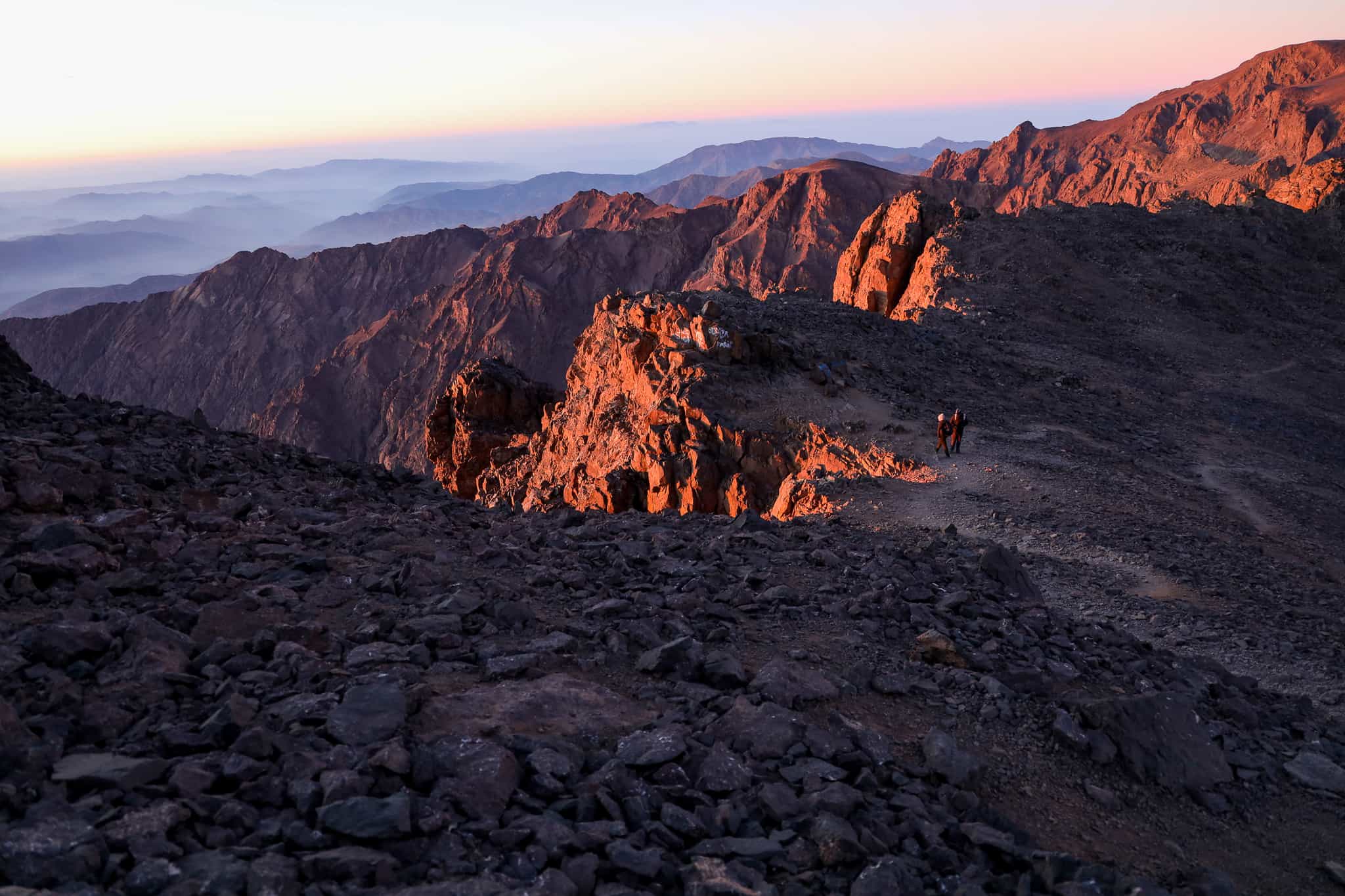
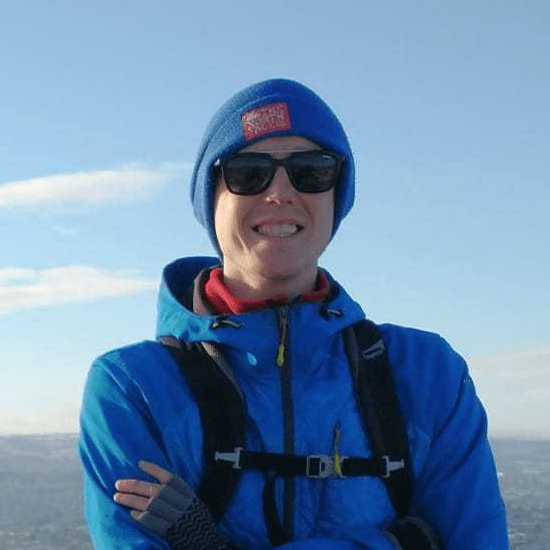
Need help finding flights?
From logistics and how to get there, to fitness, group dynamic and trip difficulty, Rory and his team of friendly experts are on hand to help.
We've got your back
Guaranteed to run
All Much Better Adventures trips are now guaranteed to run. Once you’ve booked your spot you can immediately make your travel arrangements, no uncertainty, no hanging about (excludes 'request to book' departures). Full details
Flexible payments
Secure your spot with the minimum deposit and pay off the remaining balance in as many instalments as you like, with no interest or fees. Full details
Happiness Guarantee
We’re so confident you’ll have an amazing time we’ll put our money on it. Full details
Full financial protection
To give you complete peace of mind Much Better Adventures is backed by ABTOT, ABTA and ATOL memberships. Full details
Tried & Trusted
Much Better Adventures is rated ‘Excellent’ on Trustpilot with over 1000 verified trip reviews averaging 4.8/5.
Connect before you go
You'll be invited to join a WhatsApp group to get to know each other before your big adventure together. Full details
DEPARTURE DATES
Wednesday 3rd September 2025
to Wednesday 10th September 2025
Fully Booked
Wednesday 17th September 2025
to Wednesday 24th September 2025
Fully Booked
